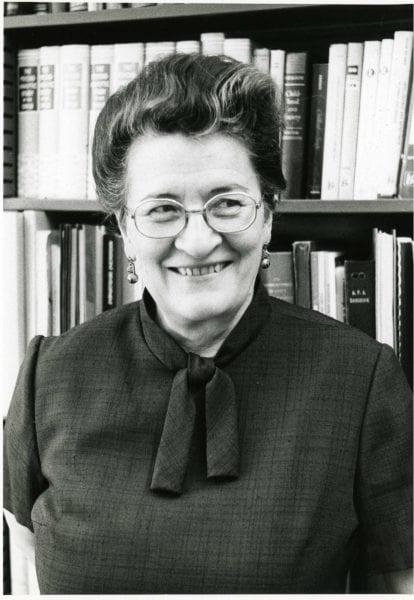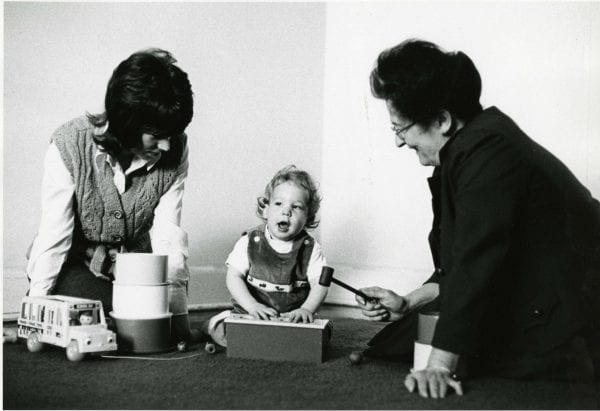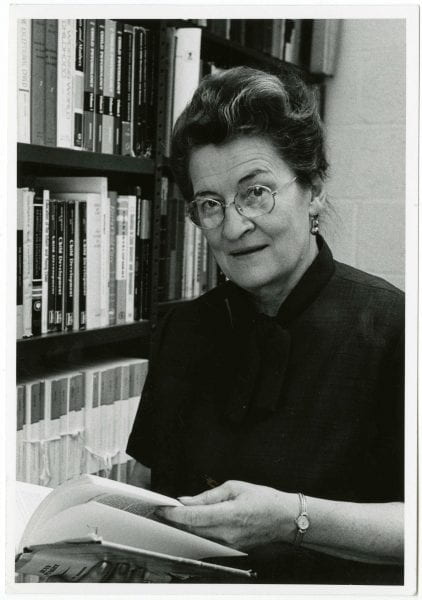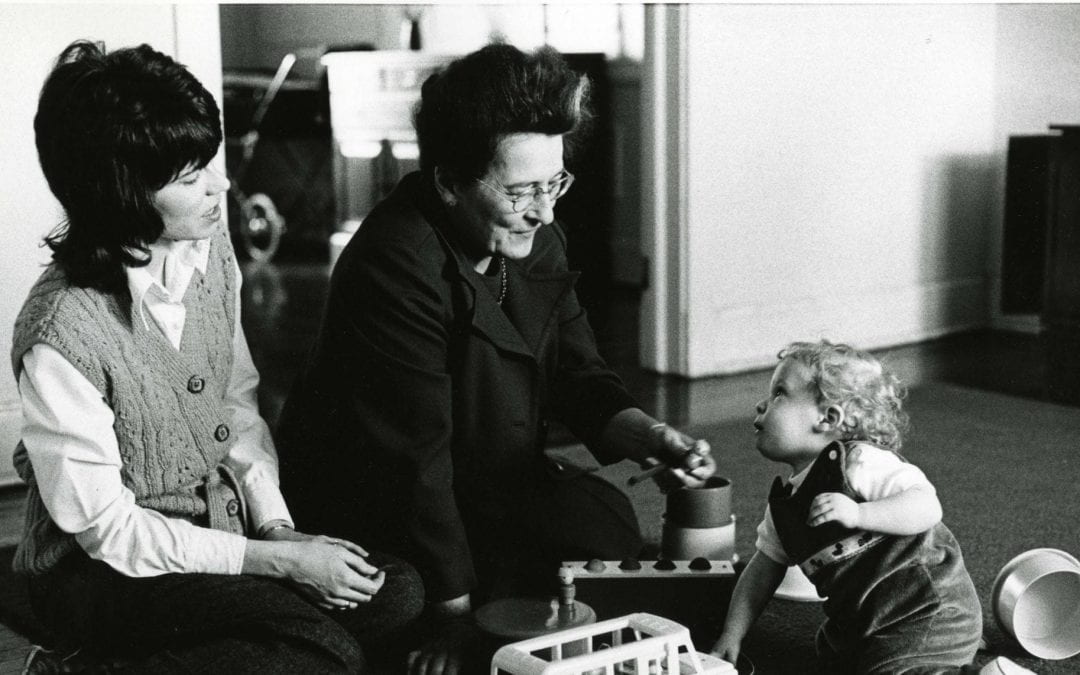By Michael Zummer ~
Best known for her Strange Situation experiment and lasting contributions to attachment theory, Canadian-American psychologist Mary Ainsworth was a pioneer in developmental psychology. She was a groundbreaking researcher into childhood attachment. Her research techniques are still in use today, while the studies she conducted have become cornerstones of modern attachment theory, which she developed with her colleague John Bowlby. Ainsworth was an influential women outside of the academic sphere, her most lasting contribution was providing the empirical basis to change recommendations made to parents.
Born Mary Dinsmore Salter in 1913 in Glendale, Ohio but raised in Toronto, Ontario, Canada, Ainsworth was an intellectually gifted child who began attending the University of Toronto at age 16.[1] Interestingly for a scholar who would become most famous for her study of childhood attachment, Ainsworth did not have a good relationship with her mother and was instead close to her father.[2]
Ainsworth pursued her doctorate in psychology at the University of Toronto earning her PhD in 1939. Her first published academic work, her dissertation, examined the role that family security played in an individuals mental health and functioning. This dissertation, “An Evaluation of Adjustment Based on the Concept of Security” was based on work by her doctoral advisor, William E. Blatz, best known for his security theory. Blatz postulated that dependent security early in life (complete trust in caregivers) provided the foundation for the the exploration and risk-taking that were necessary to develop self-confidence, or independent security. This security theory is now seen as a precursor to Ainsworth and Bowlby’s attachment theory.[3]
Upon receiving her PhD Ainsworth began looking for teaching positions. Here she encountered a stark example of gender-bias in academia. She received a job offer from the head of the psychology department at Queen’s University only to be told two weeks later that University Senate had refused to allow a woman to be appointed to the position. Despite challenge of overt gender-based discrimination in academia, Ainsworth was able to find a position at her alma mater, the University of Toronto. She taught there until 1942, when she joined the Canadian Women’s Army Corps to assist in the war effort for WWII. After four years as an army psychologist she returned to the University of Toronto where she met her husband Leonard Ainsworth.

Mary Ainsworth at approximately 50 years old. Photograph by William C. Hamilton. Source: Johns Hopkins University Sheridan Libraries, jhu_coll-0002_01320.
After their marriage in 1950 she and Leonard moved to London so he could finish his PhD at University College London. There, Ainsworth met her friend, colleague and important intellectual influence, John Bowlby. Together they would develop attachment theory. According to Ainsworth and Bowlby responsive caregivers act as a secure base from which children are able to explore the world. Bowlby was a psychiatrist, meaning he came from a medical background. Ainsworth’s main contribution to attachment theory was her research, and bringing Bowlby’s ideas into conversation with those of her doctoral advisor William Blatz.[4]
In 1954 Ainsworth moved to Uganda and there conducted her first set of mother-infant observations. This would be the groundwork for the research methods used in the Strange Situation. This cross-cultural work was extremely important as a later criticism of the original Strange Situation test was that all the mother-infant pairs studied were from middle class American families.[5] Indeed psychology in general has problem with a Western-centric focus. This makes it hard to elucidate causes of behaviors when conducting research. The need to disentangle culture and environmental factors from genetic ones is a key question of modern psychology. In this context Ainsworth’s cross-cultural study culminating in her 1967 book Infancy in Uganda: Infant Care and the Growth of Love is an admirable attempt to understand human child-rearing behavior in general, and not just Western practices. During this time she continued to collaborate with Bowlby and is known to have corresponded with him regarding her ongoing research.[6]
To understand the importance Ainsworth’s contributions it is necessary to first understand the dominant view in psychology at the time. In the mid-20th century, behaviorism was extremely influential in American psychology. This was a school of thought which prioritized the study of human behavior and believes that thoughts and emotions, while extant, are impossible to empirically observe.[7]
The leading behaviorist at the time was B.F. Skinner, most famous for his work on operant conditioning. Conditioning is an important part of behavioral psychology and was most famously studied by Ivan Pavlov who conditioned dogs to salivate at the sound of a bell by ringing a bell before he fed them Pavlovian conditioning is also known as classical conditioning, which pairs an unrelated stimulus with a response e.g. the noise of a bell and salivation.[8] Skinner was most interested in operant condition which pairs a behavior with a consequence. As an example, in a 1948 study Skinner taught rats to operate a lever to be rewarded with food.[9]
Skinner applied this to child-rearing along with the concept of reinforcement. Essentially behaviorists saw infants as looking to their mother primarily for food. Their assumption was that, infants cried, and sought attention because they wanted to be fed. Behaviorists believed that the relationship between mother and infant was based on physical need and that any emotional connection was incidental. The emotional relationship between child and caregiver was simply an evolutionary mechanism to ensure children received the care required to ensure the continuation of the species. Affection was not a need itself, rather an emotional stimulus to encourage caregiving.[10]

Mary Ainsworth playing with a child, 1973. Photograph by Richard W. Linfield. Source: Johns Hopkins University Sheridan Libraries, jhu_coll-0002_05747.
In this view of parenting, physical affection was unnecessary and even harmful. Picking up a crying child for example, was positive reinforcement for the behavior of crying. Another famous behaviorist, John B. Watson, wrote a book parenting book and recommended, “Never hug and kiss them or let them sit on your lap. Shake hands with them in the morning. Give them a pat on the head if they have made an extraordinary good job of a difficult task. If you must, kiss them once on the forehead when they say goodnight.”.[11] Watson was by no means unique in this stance, and many agreed with his underlying contention, that modern society should have a more scientific way of bringing up children.
An earlier work Care and Feeding of Children written by pediatrician L. Emmet Holt “Habitual criers should be left alone most of the time; otherwise they might become nervous.”[12] This was a bestselling book on childcare and was considered the definitive guide from its publication in 1894 to 1928 when Watson’s book was published. Holt stressed a regimented feeding schedule and limited play and physical affection.
As Bowlby and Ainsworth developed their attachment theory, this is the intellectual context that they were responding to. A school of thought that viewed people as stimulus-response machines and developed child-rearing techniques based off this simplistic model. Ainsworth particularly felt the need to respond to these parenting recommendations and criticized Bowlby for minimizing the importance of feeding.[13] Ainsworth was successful in changing doctors recommendations to mothers of young infants. Previously based on a behaviorist approach, mothers had been told to maintain a regimented feeding schedule. Thanks to Ainsworth, the medical advice shifting to feeding infants when they are hungry.[14]
Ainsworth left Africa and returned to the country of her birth in 1954. She and Leonard lived in Baltimore while Ainsworth taught as a lecturer at Johns Hopkins University. They divorced in 1960 and Ainsworth was promoted to full professor in 1963. At Hopkins she continued to experience gender based discrimination and was reportedly paid less than her male colleagues.14
In the aftermath of her divorce Ainsworth became depressed and entered therapy. She decided to return to her roots as a longitudinal researcher and conduct a study in Baltimore that mirrored her work in Uganda. The Baltimore Project was a longitudinal mother-infant interaction study consisting of monthly home observations from birth to 12 months. It culminated in the Strange Situation, a test which involved a detailed narrative designed by Ainsworth to capture the quality of mother-child interaction and test the security of attachment, all under the observation of watchful experimenters.

Mary Ainsworth at approximately 50 years old. Photograph by William C. Hamilton. Source: Johns Hopkins University Sheridan Libraries, jhu_coll-0002_01318.
In Strange Situation the mother and infant enter a room full of toys. A stranger enters and after one minute the mother departs. The mother departs for 3 minutes leaving the child alone with the stranger. She then leaves the child alone for three minutes and the stranger enters the room and tries to comfort the infant. The mother then returns and goes to pick up her child. It is important to note that this test can be conducted with any caregiver, but that in the original Baltimore Project the sample consisted of 26 mother-infant pairs. The test is designed to incrementally increase the infant’s stress level and allows the experimenter to observe the degree to which the child turns to their caregiver for security.[15]
Ainsworth found that the infant’s behavior during these trials were predicted by the quality of care and maternal affection that they received at home. She categorized the infants into three attachment styles before adding a fourth with her colleague Mary Main in 1990.[16] Ainsworth called these styles secure attachment; two types of insecure attachment, anxious-avoidant and anxious resistant; and the later style, disorganized attachment in infants who are inconsistent in their behavior.
Credit for developing attachment theory typically goes to John Bowlby[17], the British psychiatrist with whom Ainsworth worked very closely. Bowlby’s early work included a prominent study on juvenile delinquency, which correlated a history of stealing and separation from primary caregivers. Because of his experience studying families and children Bowlby was commissioned to produce a report for the World Health Organization (WHO) on the mental health of homeless children in post-war Europe. This report, published in 1951, was entitled Maternal Care and Mental Health and emphasized the importance of a warm and loving mother-child relationship. This contradicted behaviorist theories that infants’ mental life was primarily internal and was thus controversial at the time. However, it led to a widespread change of practices in orphanages and children’s hospitals.[18]
Ainsworth collaborated with Bowlby on an updated report in 1962. Also commissioned by the WHO, Deprivation of maternal care: A Reassessment of its Effects sought to provide more empirical evidence to support their theory.
The close, intellectual relationship between Ainsworth and Bowlby was fruitful for both of their academic development. Bowlby and his colleagues at the Tavistock Clinic in London pushed Ainsworth to develop a firm definition for her concept of attachment. She began to catalogue behaviors in such a way that they could be coded in an experimental setting.[19] This was extremely useful in the Strange Situation experiments.
The major contribution that Ainsworth made to attachment theory beyond her empirical demonstrations and development of attachment styles was connecting Bowlby to the “security theory” of her doctoral advisor William Blatz, which she had expanded on since her time as PhD candidate.[20] The concept of a caregiver as a secure base from which the child developed the feeling of physical and emotional safety that allowed development and exploration became Bowlby’s “attachment figure”.
In 1975 Ainsworth left Johns Hopkins for a position at the University of Virginia. She continued to write extensively on mother-infant relationships and attachment. She defended and expanded on her work, including from those attempting to politicize her research. Ainsworth continued to emphasize the importance of a stronger mother-child bond, while refusing to concede that her research should be interpreted as a recommendation that mothers stay out of the work force in order to provide proper child-care. She believed that full-time mothering was ideal, but that alternative arrangements could still provide adequately for the child’s emotional needs.[21]
Ainsworth died on March 21, 1999 at the age of 85 having retired from the University of Virginia in 1984. She stayed academically active into her late seventies. The year before her death she received the American Psychological Association’s Gold Medal Award for Life Achievement in the Science of Psychology.
Mary Dinsmore Salter Ainsworth was one of the 100 most cited psychologist of the 20th century[22] and remains a key figure in developmental psychology. Her pioneering research methods in collecting empirical data on human behavior were crucial in the creation of modern behavioral science research techniques. The attachment theory that she developed with John Bowlby remains an important part of the intellectual discourse around parenting.
But perhaps her greatest achievement was using her remarkable intellectual gifts and commitment to empirical data to drastically shift cultural beliefs about parenting. Many children lived richer, happier and healthier lives because of Mary Ainsworth. The true purpose of the social sciences is to improve quality of life through an empirical study. Mary Ainsworth achieved as much or more in this regard as anyone else. Her contributions went beyond the academic and tangibly effected parents and children around the world.
About the Author:
Michael is a 4th year student at the University of Chicago majoring in Psychology and minoring in German. He is originally from the Chicago suburbs and is a passionate Chicago sports fan. While in school he works as a Research Assistant at the Center for Decision Research a behavioral sciences laboratory based at the University of Chicago: Booth School of Business. There he helps conduct research in fields such as social and developmental psychology, and behavioral economics. Outside of school, Michael enjoys outdoor pursuits such as hiking and wake surfing. He enjoys reading books on history, psychology, international relations and various works of fiction.
References:
Featured Image: Mary Ainsworth (center) playing with a child. Photograph by Richard W. Linfield. Source: Johns Hopkins University Sheridan Libraries, jhu_coll-0002_05750.
[1] Bretherton, Inge. “Mary Salter Ainsworth.” Encyclopædia Britannica, Encyclopædia Britannica, Inc., 27 Nov. 2020, www.britannica.com/biography/Mary-Salter-Ainsworth.
[2] Gale. A Study Guide for Psychologists and Their Theories for Students: MARY SALTER AINSWORTH. 2015. p. 7.
[3] Prochner, Larry. Early Childhood Care and Education in Canada: Past, Present, and Future. UBC Press. 2011 p. 101
[4] Cherry, Kendra. “How Attachment Theory Works.” Verywell Mind, 17 July 2019, www.verywellmind.com/what-is-attachment-theory-2795337.
[5] “Mary Ainsworth.” Wikipedia, Wikimedia Foundation, 31 Oct. 2020, en.wikipedia.org/wiki/Mary_Ainsworth.
[6] Bretherton, Inge. “Mary Ainsworth: Insightful observer and courageous theoretician.” Portraits of pioneers in psychology, 2003
[7] Graham, George. “Behaviorism.” Stanford Encyclopedia of Philosophy, Stanford University, 19 Mar. 2019, plato.stanford.edu/entries/behaviorism/.
[8] Mcleod, Saul. “Pavlov’s Dogs.” Pavlov’s Dogs Study and Pavlovian Conditioning Explained | Simply Psychology, 2018, www.simplypsychology.org/pavlov.html.
[9] Krebs, John R. “Animal Behaviour: From Skinner Box to the Field.” Nature, vol. 304, no. 5922, 1983, p. 117., doi:10.1038/304117a0.
[10] Houk, Suzanne. “‘Psychological Care of Infant and Child.’” The Psychological Care of Infant and Child, 15 Mar. 2000, www.mathcs.duq.edu/~packer/DevPsych/Houk2000.html.
[11] Watson, John B. Psychological Care of Infant and Child. W.W. Norton, 1928. p. 8
[12] Holt, L. Emmet. Care and Feeding of Children: A Catechism for the Use of Mothers and Children’s Nurses. D. Appleton and Company, 1894. p. 167
[13] Ainsworth, Mary D. Salter; Tracey, Russel. Infant Feeding and Attachment. 1972.
[14] Held, Lisa. “Mary Ainsworth.” Feminist Voices, 2010, feministvoices.com/profiles/mary-ainsworth.
[15] Ainsworth, Mary D. Salter, and M S Bell. “Attachment, Exploration, and Separation: Illustrated by the Behavior of One-Year-Olds in a Strange Situation.” Child Development, 1970.
[16] Main, Mary. “The ‘Ultimate’ Causation of Some Infant Attachment Phenomena.” Behavioral and Brain Sciences, 1990.
[17] Cherry, Kendra. “How Attachment Theory Works.” Verywell Mind, 17 July 2019, www.verywellmind.com/what-is-attachment-theory-2795337.
[18] Rutter, Michael. “Clinical Implications of Attachment Concepts: Retrospect and Prospect.” Journal of Child Psychology and Psychiatry, vol. 36, no. 4, 1995, pp. 549–571., doi:10.1111/j.1469-7610.1995.tb01311.x.
[19] Bretherton, Inge. “Mary Ainsworth: Insightful observer and courageous theoretician.” Portraits of pioneers in psychology, 2003
[20] Prochner, Larry. Early Childhood Care and Education in Canada: Past, Present, and Future. UBC Press. 2011 p. 101
[21] Ainsworth, Mary. “Mary D. Salter Ainsworth.” Models of Achievement: Reflections of Eminent Women in Psychology, by Agnes N. O’Connell and Nancy Felipe Russo, Columbia University Press, 1983, pp. 200–219.
[22] Haggbloom, Steven J., et al. “The 100 Most Eminent Psychologists of the 20th Century.” Review of General Psychology, vol. 6, no. 2, 2002, pp. 139–152., doi:10.1037/1089-2680.6.2.139.

